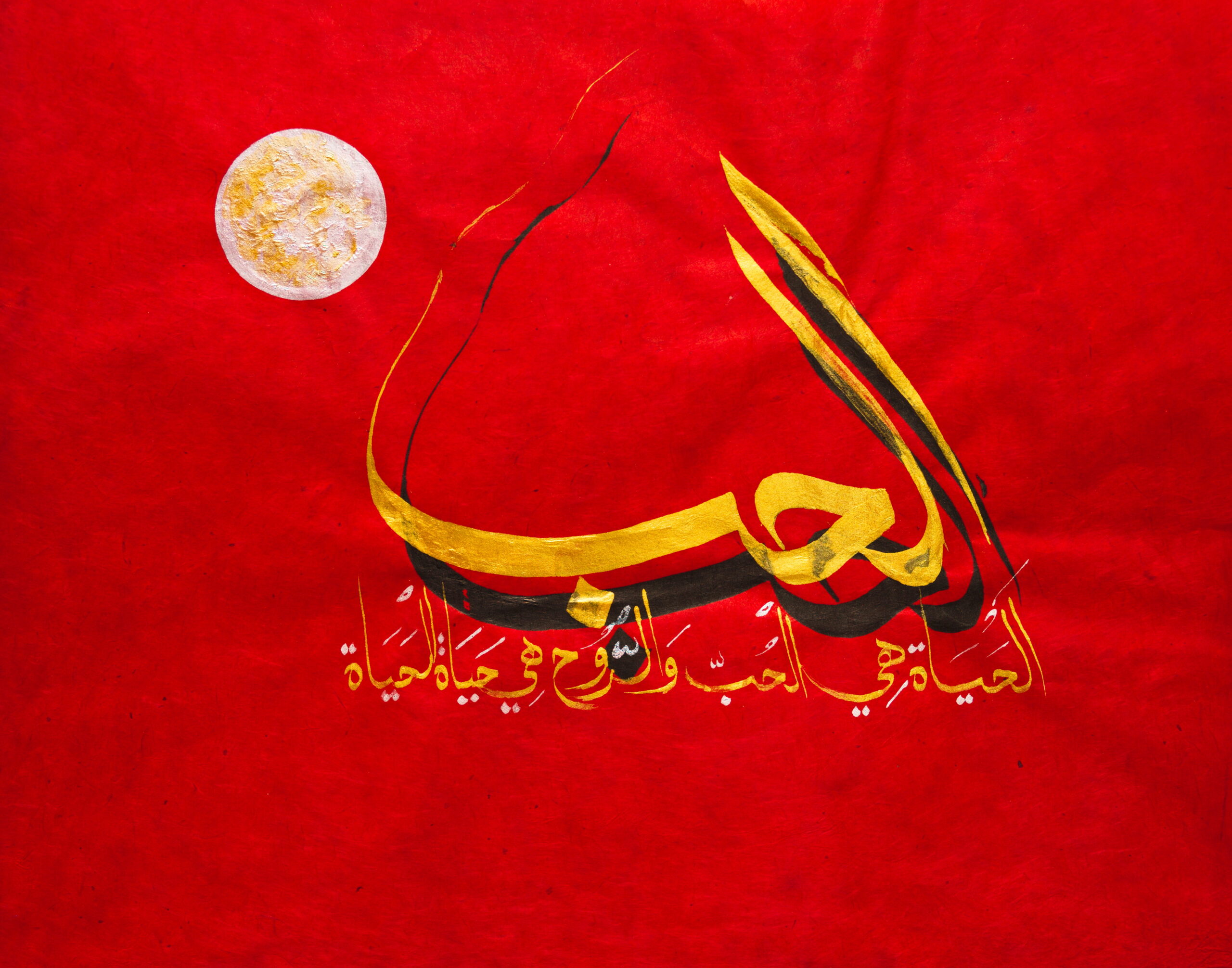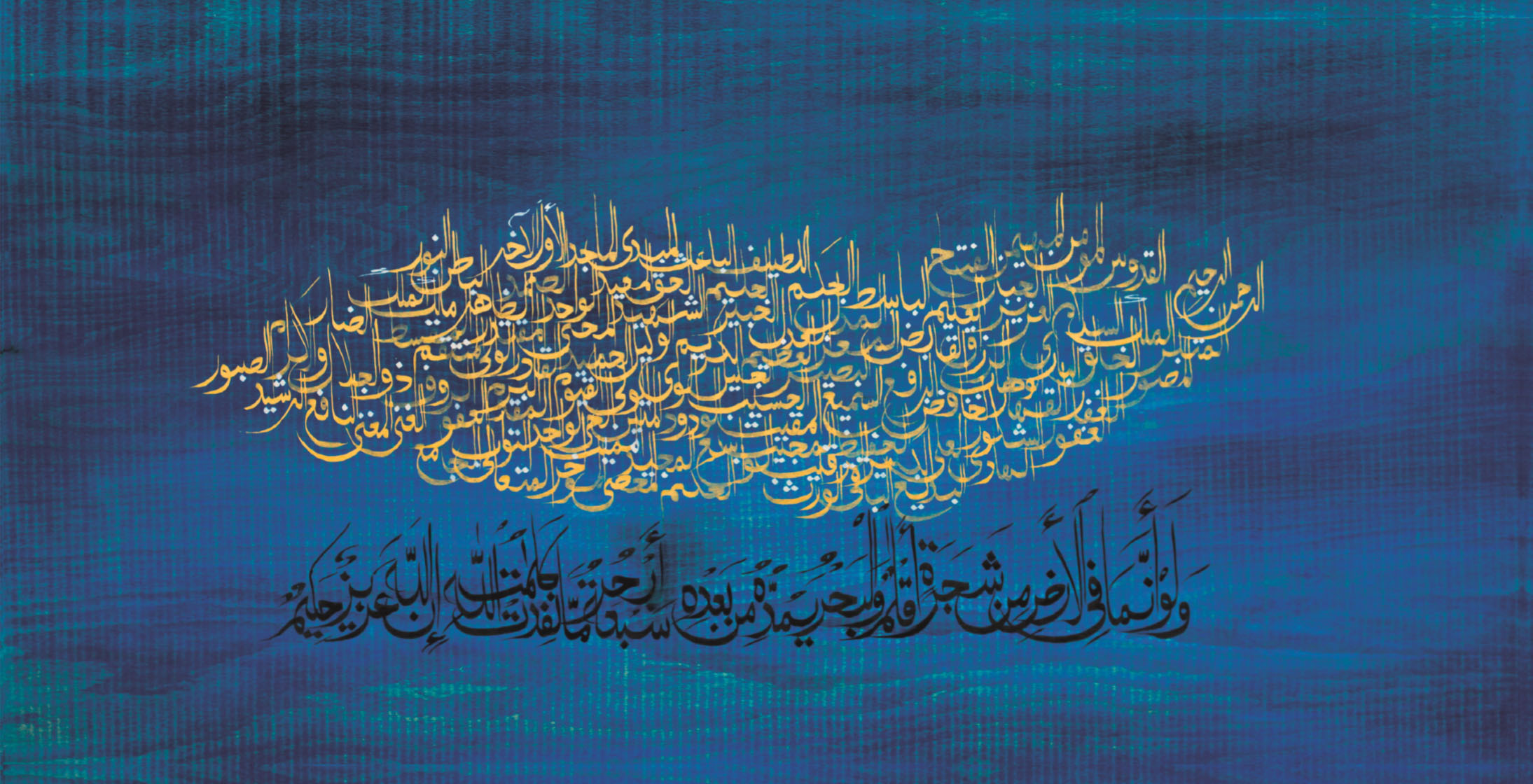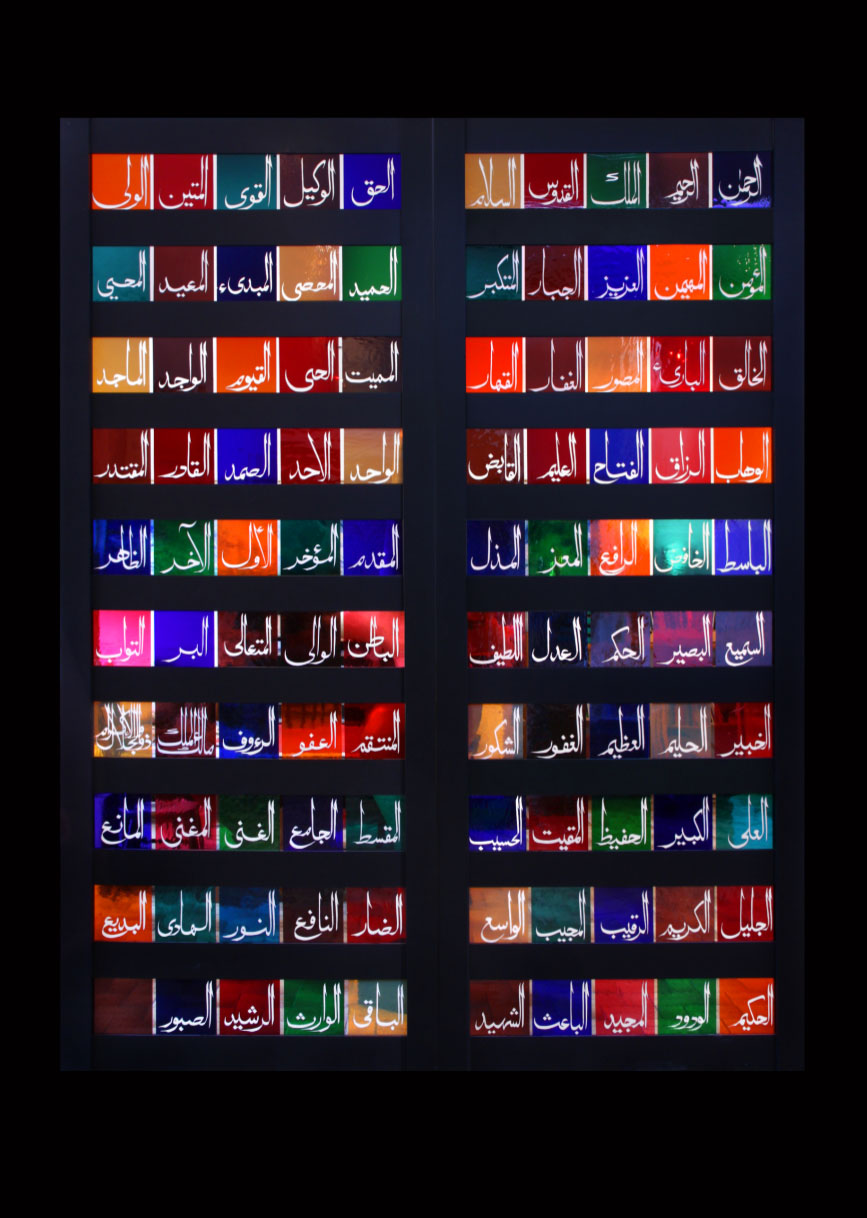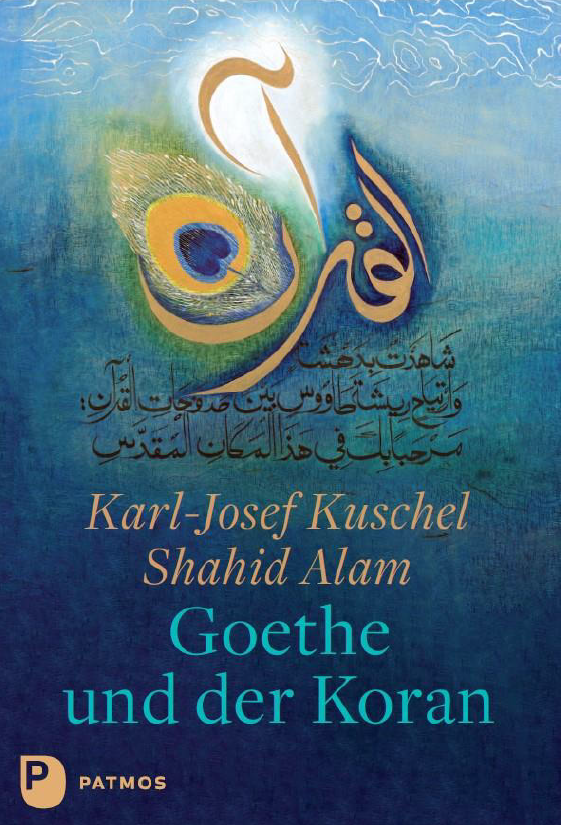(Published in German language)
Texts by Johann Wolfgang von Goethe
Commentary by Karl-Josef Kuschel
Calligraphies by Shahid Alam
Publisher Verlagsgruppe Patmos der Schwabenverlag AG Ostfildern
ISBN 978-3-8436-1246-3
Published: February 2021
God is the Orient!
God is the Occident!
Northern and southern terrain
Rest in the peace of his hands.
JOHANN WOLFGANG VON GOETHE
Both the author and the artist are available for events.
Please contact: birgit.berg-becker@verlagsgruppe-patmos.de
Shahid Alam, Calligrapher
Shahid Alam was born in Lahore/Pakistan in 1952 and has lived in his adopted home of Germany since 1973. He studied pedagogy, art, political science and European studies in Dortmund and Aachen, whereby the art of Arabic calligraphy has always accompanied him and has taken a central place in his artistic work. As an artist, he succeeds in building a bridge between Orient and Occident. He is significantly involved in an intercultural and interreligious understanding, which is supported by the aesthetics of the Arabic script. His works are visualizations of poems by great writers and mystics such as Goethe, Schiller, Rumi, Ibn Arabi and others, which he skillfully incorporates into his works as a translation, but also in the original script.
Contact
Karl-Josef Kuschel, Author
Dr. Karl-Josef Kuschel, retired professor of the Faculty of Catholic Theology at the University of Tübingen, taught theology of culture and interreligious dialogue there from 1995 to 2013. Since 2012, he has been a member of the Board of Trustees of the “Stiftung Weltethos” (Global Ethics Foundation). In 2015, he was appointed to the Board of Trustees of the Börsenverein (the German Publishers and Booksellers Association) for the award of the annual Peace Prize of the German Book Trade. He is president of the International Hermann-Hesse Society and has penned numerous publications on interreligious dialogue and on religion and literature.
E-Mail: karljosef.kuschel@uni-tuebingen.de
Goethe und der Koran (Goethe and the Koran)
Karl Josef Kuschel
The poet considers himself a traveller. He has already arrived in the Orient. He delights in customs, objects, religious attitudes and opinions, and even does not reject the suspicion that he himself is a Muselmann. J. W. GOETHE, ANNOUNCEMENT OF THE “DIVAN”, 24 FEBRUAR 1816.
Goethe and the Koran? Apart from specialists, this topic has hardly been taken seriously among Goethe admirers, who like to place the poet on a German-national pedestal. Neglected, or even ignored for a long time, the topic of “Goethe, Orient, Islam” has in the meantime been widely addressed by Goethe scholars. Literary studies have done their part with monographs, commentaries and numerous individual studies to make the dimension of the Orient/Islam in the work of the greatest German-language poet transparent. The works and publications of Katharina Mommsen, Karl Richter, Peter Ludwig, Michael Knaupp, Hendrik Birus, Anke Bosse and Anne Bohnenkamp are particularly worthy of mention. However, a broader reception and evaluation of this research in theology and religious studies in the interest of an intercultural and interreligious dialogue between the Orient and Europe or between Christianity and Islam, which is more urgently needed today than ever before, has hardly taken place.
Tolerance should actually only be a temporary attitude: it must lead to recognition. To tolerate is to offend. J. W. GOETHE, MAXIMEN UND REFLEXIONEN.
Of all the poets of the German language, Goethe had the most passionate and at the same time knowledgeable interest in the world of the Orient. Not only in its history, culture and literature, but also in its religion, Islam, which has shaped this world. Unlike any of the great poets of the German language. Well-informed by the relevant specialist literature, he knew and commented on the Koran and dealt with the path, the work and the effect of the Prophet. Two hundred years ago, Goethe had already acquired a rich knowledge of the Orient and Islam, which countless people today have yet to attain. These people tend to reduce “Islam” to a few political stereotypes and do not believe that they need to study the complex Islamic culture that has grown in the course of one-and-a-half millennia. Goethe’s penetration into the Oriental-Arab world and Oriental studies hads been virtually ignored, even by Goethe admirers, and only now is his deep interest being brought to light.
The following outlines the content of this book:
The texts
Through a compact documentation of all relevant texts by Goethe on the subject of Islam/Koran – be they in a draft drama, in poems, autobiographical testimonies or self-reports – readers are enabled to form a direct judgement. The search for traces begins in the early work and continues into the later work.
The commentary
The aim is to enable readers to understand Goethe’s texts from their contemporary context and to compare them critically with our cultural level.
The calligraphies
These works originate from the hand of one of the most important calligraphers of our time, Shahid Alam, a Pakistani-born artist who has lived in Germany for decades and runs his studio near Aachen. The collaboration with a calligrapher is all the more appropriate as Goethe himself had become enthusiastic about Arabic calligraphy. Evidence of Arabic language and writing studies are abundant in the Goethe estate.
Practising Arabic writing, experiencing writing as a physical, sensual act, is important to him, precisely “in order to get an idea of Oriental poetry and literature”. To this end, Goethe sat down once again at the age of 65 to study with specialists in Oriental studies.
Book contents
Prologue
Goethe, Islam, calligraphy and us
Part one: Johann Wolfgang von Goethe Texts
I. Excerpts from the Koran (1772/73)
Surah II * Surah III * Surah IV * V. Surah. The Table * VI. Sura. The
Cattle * X. Sura Jonah * XIII. Sura. The Thunder * XVII. Sura. The
Night Journey * XX. surah. Tah * XXIX. sura. The Spider
II. The “Mahomet” Tragedy
The drafts of a play about the prophet (1772/73) *
Goethe’s explanations of “Mahomet” in “Dichtung und
Truth” (1814)
III. Poems from the “West-Eastern Divan”
(1819) with reference to Islam and the Koran
IV. From the prose section “Besserem Verständniß” (Better Understanding)
of the ” West-Eastern Divan
V. Announcements and self-testimonies
Part two: Goethe and Islam
Commentary by Karl-Josef Kuschel
I. Studies of the Koran by the young Goethe
II. A tragedy about Mohammed, the prophet
III The Koran in the “West-östlicher Divan
IV. Goethe’s “Islam”
Epilogue:
Challenges today
Chronological table: The most important dates on Goethe and Islam Literature
About the calligraphies
Calligraphy example 1

Ink and India ink on Kahari paper, 50 cm × 60 cm
Life is love and life is spirit.
Goethe
Translated into Arabic by Adnan Abbas.
Calligraphy example 2
Oil and ink on birch wood 90 cm × 170 cm
on Sura 31, 27
And if all the trees of the earth were scribal ears,
The sea with it the ink, and with it the seven seas,
The words of God would never be exhausted,
For God is mightily wise.
(after the translation by Friedrich Rückert)
Calligraphy example 3
Made in mouth-blown glass
310 cm × 200 cm (100 panes of 20 × 20 cm each)
Usmaa-ul-husna – the 99 beautiful names of God
Goethe commented:
“He the only just
Wants what is right for everyone.
Be, of his hundred names,
This one highly praised! Amen.”
Shahid Alam on the calligraphies
In no language (perhaps) is word, spirit and writing so primordially embodied together as in the Arabic language.
J. W. Goethe
Goethe came to this realisation through his writing exercises of the Arabic script. For in no other script is the art of connecting the letters so clearly visible as in the Arabic script. The word only comes into being through the interplay of the letters, which connect with each other in a special way. The letters sacrifice their original form to connect with each other; they seek a bridge to each other, and the word created by the interplay always opens to the light. It is an expression of harmony, which is only made possible by the letters joining together to create a unified whole. The handwritten word, which comes into being through the conscious guidance of the lines, is an expression of the living. It is actually the thought that has become visible.
The breathing exercises taught by the master calligrapher Hassan Massoudi (Paris) have paved the way to inner peace while writing: In my writing exercises, I realise that the guidance of the pen is closely connected to the rhythm of breathing. The calmness or restlessness of breathing is expressed in the way the pen is guided. When I set my pen on paper or wood, I further recognise that the Arabic letters arise from vertical and horizontal movements and that each of these movements begins with a point that unfolds in vertical and horizontal lines. Thus the animate point becomes the originator of both movements, which then develop into letters through the consciously guided pen. My need to give the newly born word a dress through colours and then to place it in a dignified environment gives direction to my work: the word appears to me as a living being.
Goethe und der Koran (Goethe and the Koran)
Texts by Johann Wolfgang von Goethe
Commentary by Karl-Josef Kuschel
Calligraphies by Shahid Alam
Published by Patmos: ISBN 978-3-8436-1246-3


